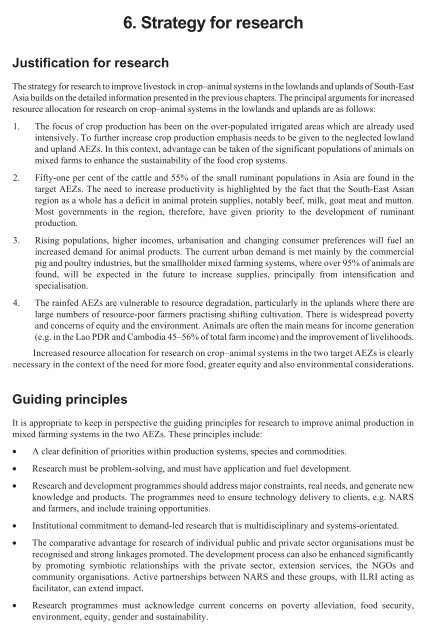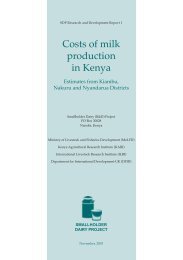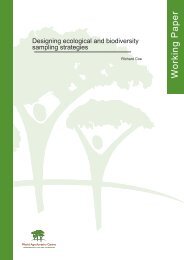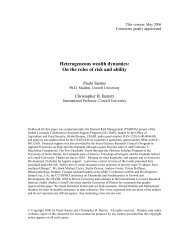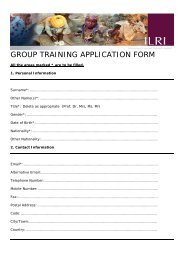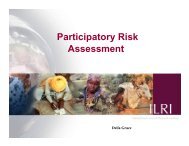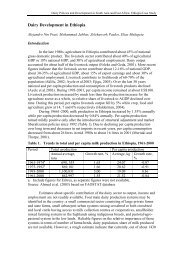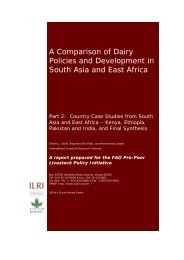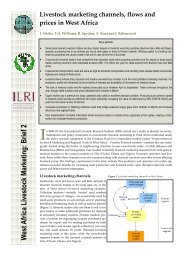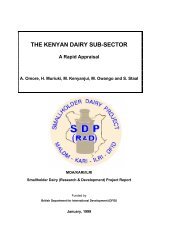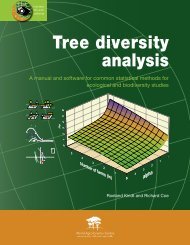Improvement of Livestock Production in Crop-Animal Systems in ...
Improvement of Livestock Production in Crop-Animal Systems in ...
Improvement of Livestock Production in Crop-Animal Systems in ...
You also want an ePaper? Increase the reach of your titles
YUMPU automatically turns print PDFs into web optimized ePapers that Google loves.
6. Strategy for researchJustification for researchThe strategy for research to improve livestock <strong>in</strong> crop–animal systems <strong>in</strong> the lowlands and uplands <strong>of</strong> South-EastAsia builds on the detailed <strong>in</strong>formation presented <strong>in</strong> the previous chapters. The pr<strong>in</strong>cipal arguments for <strong>in</strong>creasedresource allocation for research on crop–animal systems <strong>in</strong> the lowlands and uplands are as follows:1. The focus <strong>of</strong> crop production has been on the over-populated irrigated areas which are already used<strong>in</strong>tensively. To further <strong>in</strong>crease crop production emphasis needs to be given to the neglected lowlandand upland AEZs. In this context, advantage can be taken <strong>of</strong> the significant populations <strong>of</strong> animals onmixed farms to enhance the susta<strong>in</strong>ability <strong>of</strong> the food crop systems.2. Fifty-one per cent <strong>of</strong> the cattle and 55% <strong>of</strong> the small rum<strong>in</strong>ant populations <strong>in</strong> Asia are found <strong>in</strong> thetarget AEZs. The need to <strong>in</strong>crease productivity is highlighted by the fact that the South-East Asianregion as a whole has a deficit <strong>in</strong> animal prote<strong>in</strong> supplies, notably beef, milk, goat meat and mutton.Most governments <strong>in</strong> the region, therefore, have given priority to the development <strong>of</strong> rum<strong>in</strong>antproduction.3. Ris<strong>in</strong>g populations, higher <strong>in</strong>comes, urbanisation and chang<strong>in</strong>g consumer preferences will fuel an<strong>in</strong>creased demand for animal products. The current urban demand is met ma<strong>in</strong>ly by the commercialpig and poultry <strong>in</strong>dustries, but the smallholder mixed farm<strong>in</strong>g systems, where over 95% <strong>of</strong> animals arefound, will be expected <strong>in</strong> the future to <strong>in</strong>crease supplies, pr<strong>in</strong>cipally from <strong>in</strong>tensification andspecialisation.4. The ra<strong>in</strong>fed AEZs are vulnerable to resource degradation, particularly <strong>in</strong> the uplands where there arelarge numbers <strong>of</strong> resource-poor farmers practis<strong>in</strong>g shift<strong>in</strong>g cultivation. There is widespread povertyand concerns <strong>of</strong> equity and the environment. <strong>Animal</strong>s are <strong>of</strong>ten the ma<strong>in</strong> means for <strong>in</strong>come generation(e.g. <strong>in</strong> the Lao PDR and Cambodia 45–56% <strong>of</strong> total farm <strong>in</strong>come) and the improvement <strong>of</strong> livelihoods.Increased resource allocation for research on crop–animal systems <strong>in</strong> the two target AEZs is clearlynecessary <strong>in</strong> the context <strong>of</strong> the need for more food, greater equity and also environmental considerations.Guid<strong>in</strong>g pr<strong>in</strong>ciplesIt is appropriate to keep <strong>in</strong> perspective the guid<strong>in</strong>g pr<strong>in</strong>ciples for research to improve animal production <strong>in</strong>mixed farm<strong>in</strong>g systems <strong>in</strong> the two AEZs. These pr<strong>in</strong>ciples <strong>in</strong>clude:• A clear def<strong>in</strong>ition <strong>of</strong> priorities with<strong>in</strong> production systems, species and commodities.• Research must be problem-solv<strong>in</strong>g, and must have application and fuel development.• Research and development programmes should address major constra<strong>in</strong>ts, real needs, and generate newknowledge and products. The programmes need to ensure technology delivery to clients, e.g. NARSand farmers, and <strong>in</strong>clude tra<strong>in</strong><strong>in</strong>g opportunities.• Institutional commitment to demand-led research that is multidiscipl<strong>in</strong>ary and systems-orientated.• The comparative advantage for research <strong>of</strong> <strong>in</strong>dividual public and private sector organisations must berecognised and strong l<strong>in</strong>kages promoted. The development process can also be enhanced significantlyby promot<strong>in</strong>g symbiotic relationships with the private sector, extension services, the NGOs andcommunity organisations. Active partnerships between NARS and these groups, with ILRI act<strong>in</strong>g asfacilitator, can extend impact.• Research programmes must acknowledge current concerns on poverty alleviation, food security,environment, equity, gender and susta<strong>in</strong>ability.


